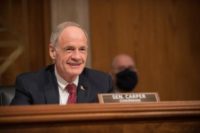A two-year budget measure that includes a $44.8-billion spending boost for 2014 has won final congressional approval, with the Senate's passage by a comfortable margin. The legislation next goes to the White House for President Obama's expected signature.
The budget bill, which the Senate approved on Dec. 18 by a 64-36 vote, would avert a government shutdown in mid-January and increase discretionary spending by a combined $63 billion for the rest of this fiscal year and all of fiscal 2015. The House had passed the measure six days earlier on a strong 334-92 vote.
The bill's 2014 spending hike would undo part of the mandatory sequestration cuts, due to take effect in January, and is particularly good news for the construction industry. Sean O’Neill, Associated General Contractors of America congressional relations director for infrastructure advancement, says, “Looking at just the top-line numbers that we're seeing, the additional discretionary spending is a positive."
Federal construction programs have been under budget pressure for the past several years and some accounts, such as water infrastructure and military buildings, took a hit in the 2013 sequestration round, which went into effect on March 1.
The bill, the product of a deal struck on Dec. 10 by House Budget Committee Chairman Paul Ryan (R-Wis.) and Senate Budget Committee Chairman Patty Murray (D-Wash.), sets only the overall total figures for discretionary spending. It does not specify amounts for individual budget accounts.
Congressional appropriations committees will make those line-item decisions in the coming weeks as they work out an expected omnibus package to fund the government from Jan. 15 through Sept. 30, when fiscal 2014 ends. The appropriations panel chairs, Sen. Barbara Miklulski (D-Md.) and Rep. Harold Rogers (R-Ky.), now will have an additional $44.8 billion to divvy up among the array of spending accounts in those FY14 negotiations. That $44.8 bllion will be split evenly between defense programs and non-defense programs.
Competition for those new dollars will be intense. "There is generally a lot of support for infrastructure," says Cathy Connor, Parsons Brinckerhoff senior vice president and manager of federal government affairs. But in seeking their shares of the additional funds, public-works advocates will have to vie with strong pushes from backers of medical research, education and other non-construction programs.
In all, the budget measure allots $1.012 trillion for discretionary spending in FY14—midway between the $967 billion contained in the budget resolution the House approved in March and the $1.058 trillion in the version the Senate cleared the same month.
Within the $1.012 trillion, defense would get $520.5 billion and non-defense would get $491.8 billion. Defense includes military construction; most other federal building programs fall under the non-defense category.
Most of the bill's spending hike is front-loaded into 2014. For year two of the measure, 2015, the bill raises discretionary spending only slightly, to $1.014 trillion. Defense would get a $908 million increase over the measure's 2014 mark; non-defense would receive just $683 million more than its proposed, new 2014 level.
The new budget bill is nowhere close to the "grand bargain" that some observers had talked about over the past few years. But in past few weeks, it had become clear that Ryan and Murray were heading for a much narrower deal. Ryan said the agreement falls short of what he desired but is still "a step in the right direction."
Story updated on Dec. 18 to include Senate vote.



Post a comment to this article
Report Abusive Comment